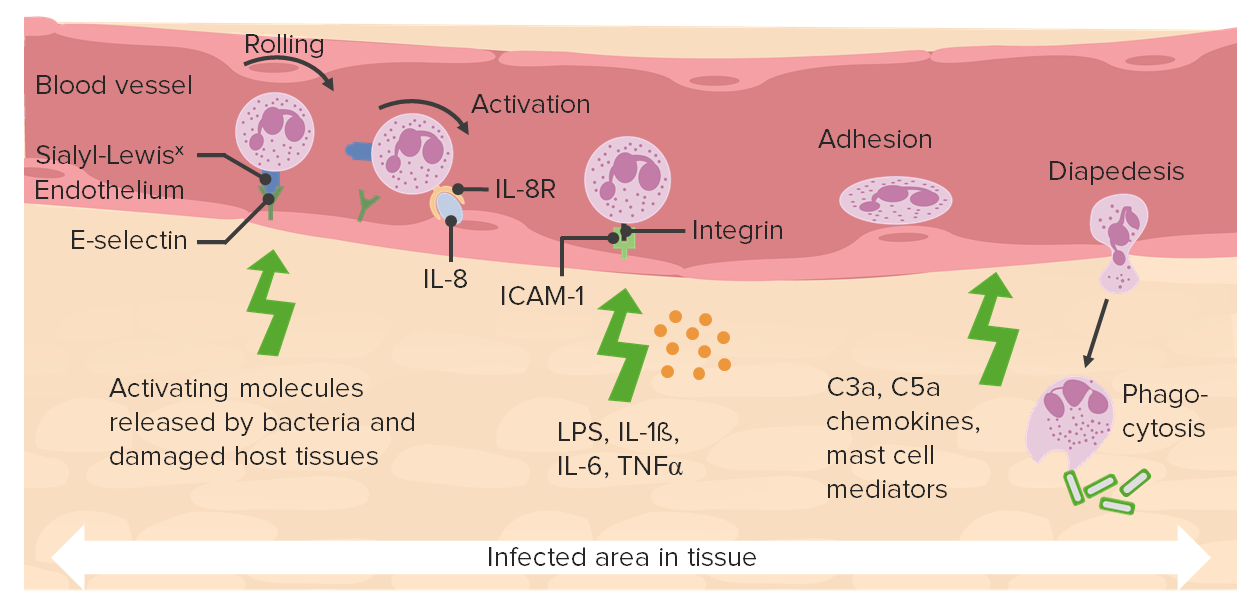Playlist
Show Playlist
Hide Playlist
Neutrophil Rolling
-
Slides Acute and Chronic Inflammation Cellular response.pdf
-
Reference List Pathology.pdf
-
Download Lecture Overview
00:00 Okay, so we've had that initial trigger, and we've released the molecules, that's what's down in that lower right hand corner macrophages and mast cells, and other cells in that extravascular space are releasing mediators that tell the endothelium, gets sticky. 00:18 So they're also telling the endothelium, be leaky. 00:22 As a result of that, we now have a sticky surface, and the leukocytes are able to bounce over the surface of that, and it will begin to bind to molecules called selectins. 00:35 That's on the next slide. 00:37 So this rolling involves selectins. 00:39 That's actually a good name for a molecule. 00:41 It's a selective lectin. 00:43 Meaning that it selectively binds certain sugars. 00:46 So on the bottom, you see it's an endothelial cell and sticking up from that is a protein called a selectin. 00:53 and there are various kinds of selectins, we'll talk about briefly. 00:56 It sticks up above the glycocalyx. 00:59 So it's well into the bloodstream. 01:01 And on the end, is a little receptor that will bind sugars. 01:05 And it tends to bind a complex of sugars, not just one kind of sugar. 01:10 The most common sugar complex it's bound is called Sialyl-Lewis X. 01:15 And it involves at least four different sugar groups a fucose, and an N-acetyl glucosamine, a galactose, and an N-acetylneuraminic acid. 01:25 Details? Not too important. 01:27 But that's what those different things mean in the green balls. 01:31 Those are on the surface of various glycoproteins on the neutrophil. 01:35 And so when you have selectins that have been activated, making the endothelium sticky, now the neutrophils bouncing over the surface will be able to bind to those. 01:45 So more words about selectins. 01:48 It's a lectin-like binding domain, it binds to carbohydrates. 01:52 That's why it's called a selective lectin. A selectin. 01:55 There are three members. 01:56 So there is E-selectin, that's on endothelial cells. 01:59 Easy to remember, E-selectin on endothelial cells. 02:03 It binds that Sialyl-Lewis X. 02:06 There is P-selectin. It was originally described on platelets. 02:09 That's why it's called P-selectin but it's also an endothelial cells. 02:13 And it also binds Sialyl-Lewis X. 02:16 And then, in the same way that we have selectin that are in endothelial cells, we can also have selectins that are expressed on the leukocyte that bind sugars present on the endothelium. 02:28 Okay, pretty straightforward. 02:29 And you don't need to know the names, but they're there for your reference. 02:33 How do we regulate the expression of the selectins? Well, one, the L-selectin, that lectin binding protein that's on leukocytes, is constitutively expressed. 02:44 It's always there at a low level. 02:47 It makes the leukocyte stick until they start bouncing over the surface of the endothelium and rolling. 02:53 So we can have them expressed at a low level all the time. 02:59 We can redistribute from intracellular stores, P-selectin. 03:05 So the way that we regulate P-selectin expression, it's always sitting inside an endothelial cell, ready to go. 03:12 But until we signal it, until we stimulate that cell with certain mediators coming from the mast cells in the macrophages, they don't move it from the inside to the outside. 03:22 But the minute they get stimulated, they move it out to the surface, and now that endothelial cell will become sticky because of the expression of the P-selectin. 03:33 We can also have various inflammatory mediators that drive endothelial expression of new selectins. 03:40 So, E-selectin is actually driven by inflammatory mediators like Tumor Necrosis Factor, that's TNF, or interleukin-1. 03:49 So the cell doesn't make it until we stimulate it with inflammation. 03:54 So those are different ways that we can keep cells from sticking until we're ready. 04:01 That Selectin-mediated Rolling. 04:03 Here, the cells are going from left to right moving along here. 04:08 The selectins and the binding sites, the receptors are at the very tip of the leukocyte. 04:16 So leukocyte is not a round ball. It's not a smooth ball. 04:19 It's more like a sea urchin with lots of little spikes all the way around it. 04:24 And on the tips of that are the receptors, the sugar expression, the Sialyl-Lewis X, that will bind to the selectin that's been expressed on the endothelium. 04:35 So the receptors expressed to the microvilli tip. 04:38 It's a very low-affinity interaction, and allows the cells to roll. 04:42 And they stick and then they release. 04:44 And they stick and then they release. 04:46 It's a very fast on and off rate. 04:47 The shear forces because they're shear going from left to right, constantly rolling the cell. 04:54 So it may take a while before they get to firm adhesion. 04:57 And we get repetitive attachment and detachment. 05:00 Okay. So that's how you get rolling.
About the Lecture
The lecture Neutrophil Rolling by Richard Mitchell, MD, PhD is from the course Acute and Chronic Inflammation.
Included Quiz Questions
Which of the following mediates the binding of leukocytes to P-selectin on endothelial cells?
- Sialyl LewisX
- Von Willebrand factor
- Prostaglandin E2
- Platelet-derived growth factor
- Interleukin 8
How is E-selectin expression regulated?
- De novo synthesis
- Low-level constitutive expression
- Redistribution from intracellular stores
- Recycling from the damaged endothelial cells
- Release from the activated leukocytes
Which of the following best describes neutrophil rolling?
- Repetitive attachment and detachment
- High-affinity interactions
- Integrin-mediated interactions
- Low on-off rates
- Guided by the chemotactic agent C5a
Customer reviews
5,0 of 5 stars
| 5 Stars |
|
5 |
| 4 Stars |
|
0 |
| 3 Stars |
|
0 |
| 2 Stars |
|
0 |
| 1 Star |
|
0 |




